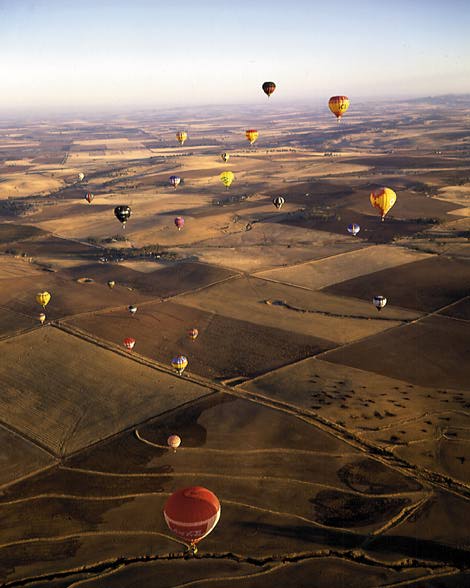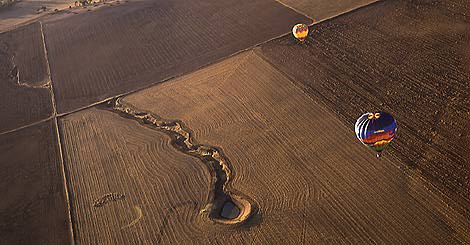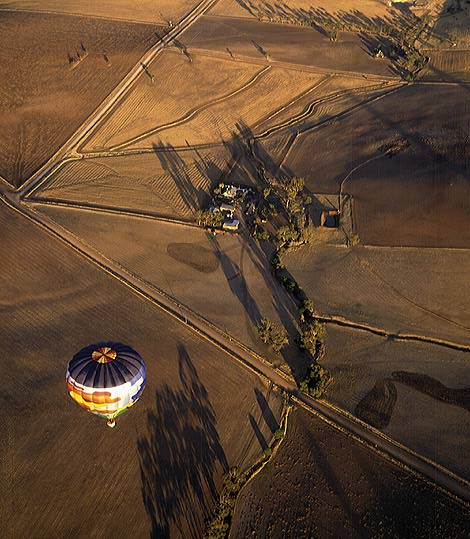

David Usill describes his Window on the World library of 70,000 images as a source for offbeat travel pix and hot-air ballooning photography - and he is now developing a CD-ROM system for distributing the images under the same title, whatever intentions multinational software corporations may have on such a good trademark.
Every freelance seems to shoot pictures of balloons. You can't open a copy of amateur photo magazines without seeing the same nearly-identical pictures of the same well-known hot air balloons.
David starting photographing from balloons instead in 1987. He has flown all over the world building up his collection in the process.

Working as a conventional travel photographer he has photographed (amongst many other locations) Easter Island, Australia, Cuba and China. His balloon trips include Australia, Thailand, Canada, Northern Cyprus, France, and Italy, all of which have added to the slide library. Plans are afoot to photograph The Nile Valley and the pyramids using the balloon as a platform for the photography.
The whole operation is run from his company Mantis Studio, a desktop publishing and photography unit producing design for print with the use of photography as the significant element. Amonst his clients for this side of his business are most of the classical major record labels and travel companies.
Situated behind Waterloo Station, London, the studio is guarded by a Range Rover you have to squeeze past to get into the front door, but this is no status symbol.
"We use it to collect the balloon after we've landed from a trip", says David's wife Judith. "Driving over a ploughed field or wet moorland, then loading up a balloon, basket and propane cylinders isn't really a job for a Nissan Micra."
There are two items David finds essential for both the travel photography and the ballooning. The first is a monopod with a swivel head. It adds stability to the camera for the kind of lighting levels he encounters in the early morning and evenings when flying. It occupies less space than the conventional tripod in the basket and it is also less intrusive when working in local markets in foreign climes.
The other item is a polarising filter, which is useful when flying as it cuts out some of the specular reflections off the ground when seen obliquely from the air, and intensifies colour and contrast by cutting through the atmospheric haze.
His camera gear was originally a Nikon F2 with a complete range of lenses, but he wanted to move up to a larger format to get an increase in the quality. He started using Hasselblad eight years ago but found it too heavy for travel work. He now uses a Bronica ETR-Si 6 x 4.5cm SLR both for his travel and portrait work.

"Baskets in balloons vary in size, but the small ones which we use to make the balloons more maneouvrable will only take two people. I once bought a Plaubel Makina 6 x 7cm, which because of its compact size fitted into specially made pockets on the propane cylinders. It was the best camera I�ve ever used for ballooning, and the 6 x 7 format offered an increase in quality."
Sadly now discontinued, there were two versions of this rangefinder camera, the 670 with a Nikon 80mm f2.8 and the 67W with a 55mm f4.5. Both sell for more now than they cost in the mid-1980s - a clean wide-angle version will fetch �1,500 ($2,300).
Flying across the English Channel one day the balloon dropped from 500 feet into the sea when suddenly hitting a warm air pocket. Unfortunately for David as the basket struck the surface the Plaubel bounced out of the basket into the sea he hastens to add that he was not the pilot in charge of that particluar flight!
He now uses the nearest current equivalent to the Plaubel, a Mamiya 6 with its three interchangeable lenses of 50mm, 75mm and 150mm, fields of view of 75, 55 and 30 degrees respectively. Lightweight and tough, he finds this rangefinder camera's lenses very sharp for his work. The smooth electronic shutter is also invaluable.
David uses Fujichrome Provia 100 as he likes the added benefit of being able to push the development by several stops with little loss of quality. It also comes in 220 rolls for 24 shots, which means less changing of film when flying.
His clients now range from balloon companies needing brochures, travel companies, ballooning competitions and events to anyone else wanting to feature balloons in advertising, corporate literature. He still shoots those colourful pictures of balloons seen from the ground - but for our money it's the shots of the ground from balloons, with or without a balloon in view, which are the real 'window' on the world.
� Steve Newman